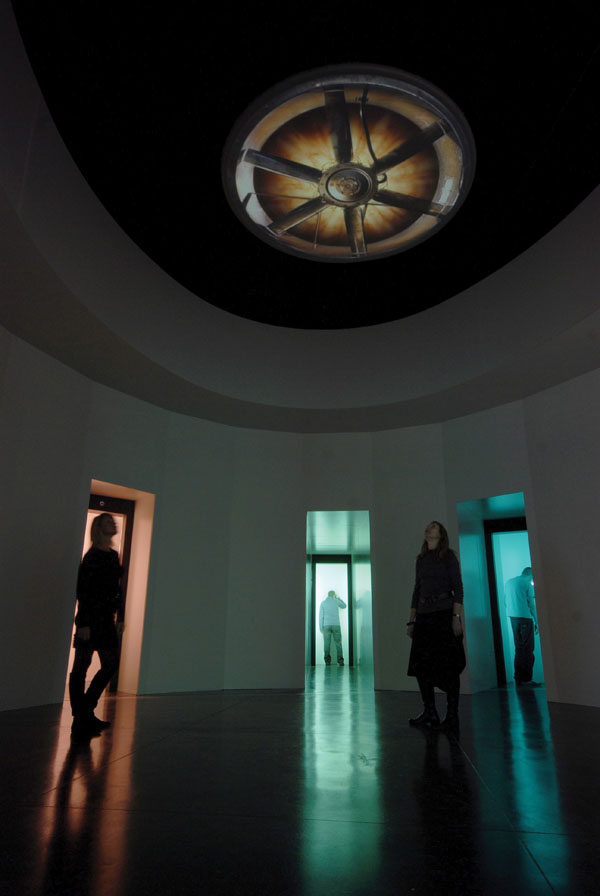
The entrance to Almost Everywhere Apparent extends a highly physical invitation to its visitor: turn a non-descript white door and walk into an equally anonymous antechamber. Door follows door. Gradations of light give way to the dusky glow of a narrow corridor; choral music and singing voices surround us, creating an unnerving sonic atmosphere that plays upon our bodily sensitivity to sound. The interplay of space and architecture, sound and voice beckon us to proceed (and enter into a ghostly phenomenology of listening and hearing) at our own risk. The passageway suddenly veers off, as if the architecture of the space were shifting only to leave the body lagging behind. We arrive at a huge vaulted space with a (projected) overhanging dome; a series of centrifugal corridors radiate out from this open chamber. Each ends with a lens embedded in the wall through which we view intriguing but apparently disconnected 'peep-shows' (an amorphous mass of black clad-figures, clinging to a ceiling, the image of a choir from on-high). Different sounds and vocalizations continue to surge throughout the hub; a sonic palimpsest keeps us guessing, on edge.
On an affective level, this piece beautifully calls up the spectral or ghostly nature of sound itself, as a kind of absent presence; absent in its invisibility but present in its reverberation in and through the body that encounters it. Unfortunately, the use of sound tends to be overwhelmed by the more tangible groundings of image/architectural layout in the main chamber, which offers us a far less creepy experience of the acoustic than entering the work. Unable to pinpoint any exact auditory location to its echoic effects, the entrance gives greater license to the potentially disorientating effects of listening, rather than privileging surveillance/viewing. The main chamber, by contrast, seems labored and overly 'cerebral' in its allusions to the architectural motifs of the panopticon or the sprawling aisles of a cathedral.
The fusion of the religious with the institutional, the sacred and surveillance, also comes at the expense of downplaying the architectonic dimensions of sound itself. As philosopher, Michel Chion, often remarks, sound tends to 'fill' a space in a way that the image simply cannot; it possesses a multi-directional quality and its contours are far less certain or easily identifiable. Sound, in its ambience, naturally lends itself to the reign of phantasms.
Almost Everywhere Apparent is an uneven but potent realization of how spatially complex and affectively immediate our response to the acoustic realm can be. A less didactic mix of sound and structure might have yielded more interesting and sensually perplexing results. The installation is at its most evocative when you close your eyes and listen, letting yourself become haunted by the acoustic ghost.












